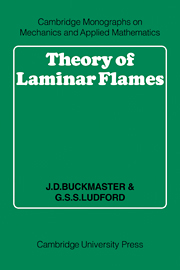Book contents
- Frontmatter
- Contents
- Preface
- 1 Governing equations of combustion
- 2 The premixed plane flame
- 3 Perturbations: SVFs and NEFs
- 4 Steady burning of a linear condensate
- 5 Unsteady burning of a linear condensate
- 6 Spherical diffusion flames
- 7 Cylindrical and spherical premixed flames
- 8 Multidimensional theory of premixed flames
- 9 Burners
- 10 Effects of shear and strain
- 11 Stability
- 12 Ignition and explosion
- Text references
- Further references
- Citation Index
- Subject Index
8 - Multidimensional theory of premixed flames
Published online by Cambridge University Press: 05 May 2010
- Frontmatter
- Contents
- Preface
- 1 Governing equations of combustion
- 2 The premixed plane flame
- 3 Perturbations: SVFs and NEFs
- 4 Steady burning of a linear condensate
- 5 Unsteady burning of a linear condensate
- 6 Spherical diffusion flames
- 7 Cylindrical and spherical premixed flames
- 8 Multidimensional theory of premixed flames
- 9 Burners
- 10 Effects of shear and strain
- 11 Stability
- 12 Ignition and explosion
- Text references
- Further references
- Citation Index
- Subject Index
Summary
The flame as a hydrodynamic discontinuity
The plane premixed flame discussed in Chapters 2 and 3 is an idealization seldom approximated, since in practice the flame is usually curved. A Bunsen burner flame is inherently so; but even under circumstances carefully chosen to nurture a plane state, instabilities can precipitate a multidimensional structure. Such flames have been extensively studied using a hydrodynamical approach (Markstein 1964, p. 7); a brief description of it will provide an introduction to our subject.
On a scale that is large compared to its nominal thickness λ/cpMr, the flame is simply a surface across which there are jumps in temperature and density subject to Charles's law (as appropriate for an isobaric process). Deformation of the surface from a plane is associated with pressure variations in the hydrodynamic fields of the order of the square of the Mach number (see section 1.5). These small pressures jump across the surface to conserve normal momentum flux. Because Euler's equations for small Mach number hold outside the flame (cf. the end of section 3), the temperature and density do not change along particle paths; so that for a flame traveling into a uniform gas the temperature and density ahead are constant and the flow is irrotational. The flow behind is stratified, however, since flame curvature generates both vorticity and nonuniform temperature jumps. Variations in temperature from the adiabatic flame temperature are usually neglected everywhere (a matter we shall treat later); but vorticity generation cannot be ignored so that, even though Euler's equations apply behind the flame, the flow is not potential there.
- Type
- Chapter
- Information
- Theory of Laminar Flames , pp. 136 - 153Publisher: Cambridge University PressPrint publication year: 1982

